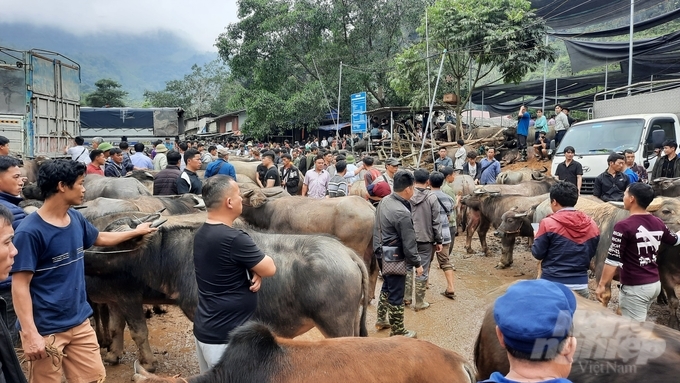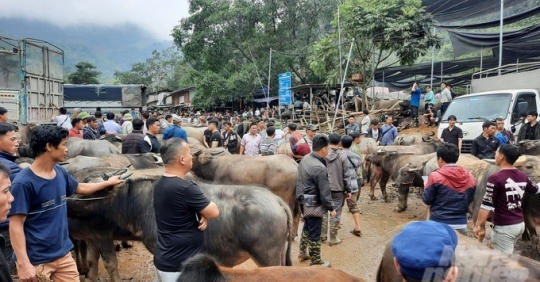
The Nghien Loan Market, the largest buffalo and cow market in the north, has a transaction level of just 50% compared to before the Covid-19 epidemic in 2020. Photo: Math Nguyen.
The Nghien Loan market in Pac Nam district of Bac Kan province is one of the largest buffalo and cow markets in the north. Before 2020, before the Covid-19 epidemic emerged and broke out worldwide, each market would gather an average of 1,500 to 2,000 buffaloes and cows from around the world to trade here. But now the number has dropped by about half and now averages around 800-900.
Most notably, in the past, buffalo and cows were 20% in the church, down from 5% at the last meeting (November 19). The reason is that people in Nghien Loan township mainly breed buffalo and cows in the form of fattening, buy lean and then sell them when fat, but now the prices of buffalo and cows have fallen very low, per kilogram Steam only around 55,000 – 60,000 VND/kg steam while before it reached 105,000 – 110,000 VND/kg. Meanwhile, the price of bran and other foods is still high, causing losses, and people no longer increase it.
Ms. Ly Thi Thuyet, Chairwoman of the Nghien Loan Commune People’s Committee, said: Previously, large numbers of buffalo and cows were purchased and transported to China through Cao Bang Province. However, due to the epidemic prevention policy, the Chinese side stopped importing, even people in Cao Bang province districts such as Bao Lac, Bao Lam and Nguyen Binh had to bring them to Nghien Loan Market for consumption. Now they only sell to private traders in the lowland provinces like Thai Nguyen, Hanoi, Bac Ninh, Hai Duong,… they push the price down like that.
Not only do small farmers lose money due to low prices for buffalo and cows and stop raising livestock, but also large livestock farms in Bac Kan province find themselves in this situation. The rearing of commercial buffalo and cows finds itself in a situation where much is bought but little is sold. Mainly imported cows and other hybrid cows.
Mr. Nguyen Trong Thang’s farm in Phieng My Residential Community, Huyen Tung District, Bac Kan City is a case in point. Currently the farm has over 170 crossbred cows hailing from the UK, France, USA, Australia and New Zealand. Most of these cows are breeding cows and calves. Due to low prices, he mainly sells bulls for meat and he keeps cows for breeding.

A Thang wants the Chinese market to reopen so the value of buffalo and cows return to the same levels as before. Picture: Math Nguyen.
Mr. Thang said he was able to maintain the cow farm by being able to control the source of cattle feed and mastering the artificial breeding method. Commercial bulls have production that can be easily sold to the cities, but the low price still needs to be sold to have a source of income to pay for labor and capital turnover. I also look forward to the Chinese market reopening soon for value to return. But now the price of buffalo and cows has fallen sharply and is below the price of live pork.
The fact that China has not opened the door has caused buffalo and cows from the border area to turn back and forth, which is a problem encountered in the border districts of Cao Bang province such as Bao Lam, Bao Lac, Ha Quang , Trung, Khanh, Ha Lang, Thach An. Buffalo and cows used to gather in these places across the country to await export to China, but now it’s the other way around.
Mr. La Hoai Nam, secretary of the Party Committee of Bao Lac County, Cao Bang Province, said: Because the Chinese side closed the border with buffalo and cows, this kind of commodity was old and had to be exported to lowland provinces. The price of local buffalo and cow is very cheap, the earlier buffalo was about 60 million now only half, or the earlier cow had to be 20-25 million, now the price is pushed down to 9-10 million.
Therefore, local authorities and growers should be very careful that the Chinese market will be opened soon so that local production and business can flourish again. Not only raising buffalo and cows, but also goats, horses or other agricultural products can be exported, increasing the value of economic production in general.

